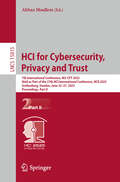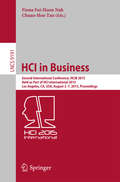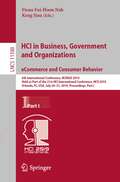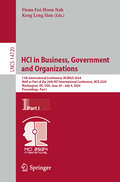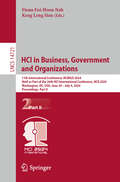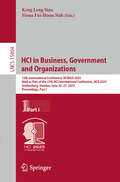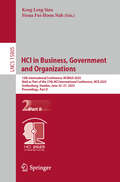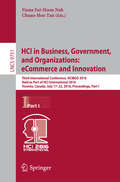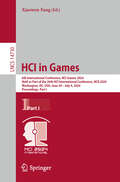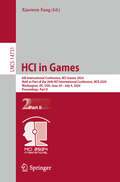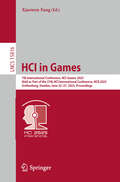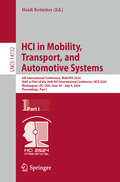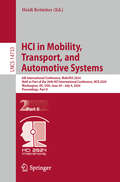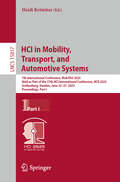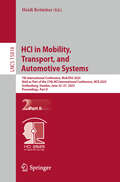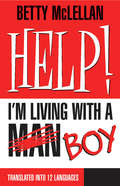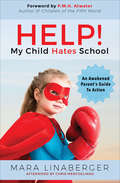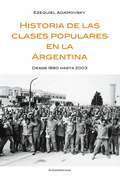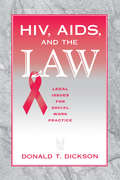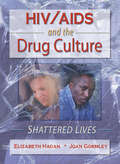- Table View
- List View
HCI for Cybersecurity, Privacy and Trust: 7th International Conference, HCI-CPT 2025, Held as Part of the 27th HCI International Conference, HCII 2025, Gothenburg, Sweden, June 22–27, 2025, Proceedings, Part II (Lecture Notes in Computer Science #15815)
by Abbas MoallemThis book constitutes the refereed proceedings of the 7th International Conference on Cybersecurity, Privacy and Trust, held as Part of the 27th International Conference, HCI International 2025, in Gothenburg, Sweden, during June 22–27, 2025. Two volumes of the HCII 2025 proceedings are dedicated to this year&’s edition of the HCI-CPT conference. The first volume focuses on topics related to Human-Centered Cybersecurity and Risk Management, as well as Cybersecurity Awareness, and Training. The second volume focuses on topics related to Privacy, Trust, and Legal Compliance in Digital Systems, as well as Usability, Privacy, and Emerging Threats.
HCI for Cybersecurity, Privacy and Trust: First International Conference, HCI-CPT 2019, Held as Part of the 21st HCI International Conference, HCII 2019, Orlando, FL, USA, July 26–31, 2019, Proceedings (Lecture Notes in Computer Science #11594)
by Abbas MoallemThis book constitutes the thoroughly refereed proceedings of the First International Conference on HCI for Cybersecurity, Privacy and Trust, HCI-CPT 2019, which was held as part of the 21st HCI International Conference, HCII 2019, in Orlando, FL, USA, in July 2019.The total of 1275 papers and 209 posters included in the 35 HCII 2019 proceedings volumes were carefully reviewed and selected from 5029 submissions. HCI-CPT 2019 includes a total of 32 papers; they were organized in topical sections named: Authentication; cybersecurity awareness and behavior; security and usability; and privacy and trust.
HCI in Business
by Fiona Fui-Hoon Nah Chuan-Hoo TanThis volume constitutes the refereed proceedings of the Second International Conference on HCI in Business, HCIB 2015, held as part of the 17th International Conference on Human-Computer Interaction, HCII 2015, which took place in Los Angeles, CA, USA, in August 2015. HCII 2015 received a total of 4843 submissions, of which 1462 papers and 246 posters were accepted for publication after a careful reviewing process. The papers address the latest research and development efforts and highlight the human aspects of design and use of computing systems. They thoroughly cover the entire field of human-computer interaction, addressing major advances in knowledge and effective use of computers in a variety of application areas. The 72 papers presented in this volume address the following topics: social media for business, enterprise systems, business and gamification, analytics, visualization and decision- making, industry, academia, innovation, and market.
HCI in Business, Government and Organizations. eCommerce and Consumer Behavior: 6th International Conference, HCIBGO 2019, Held as Part of the 21st HCI International Conference, HCII 2019, Orlando, FL, USA, July 26-31, 2019, Proceedings, Part I (Lecture Notes in Computer Science #11588)
by Fiona Fui-Hoon Nah Keng SiauThis two-volume set LNCS 11588 and 11589 constitutes the refereed proceedings of the 6th International Conference on Business, Government, and Organizations, HCIBGO 2019, held in July 2019 as part of HCI International 2019 in Orlando, FL, USA. HCII 2019 received a total of 5029 submissions, of which 1275 papers and 209 posters were accepted for publication after a careful reviewing process. The 63 papers presented in these two volumes are organized in topical sections named: Electronic, Mobile and Ubiquitous Commerce, eBanking and Digital Money, Consumer Behaviour, Business Information Systems, Dashboards and Visualization, Social Media and Big Data Analytics in B
HCI in Business, Government and Organizations: 11th International Conference, HCIBGO 2024, Held as Part of the 26th HCI International Conference, HCII 2024, Washington, DC, USA, June 29 – July 4, 2024, Proceedings, Part I (Lecture Notes in Computer Science #14720)
by Fiona Fui-Hoon Nah Keng Leng SiauThis two-volume set of HCIBGO 2024 constitutes the refereed proceedings of the 11h International Conference on HCI in Business, Government and Organizations, held as part of the 26th International Conference, HCI International 2024, which took place in from June 29 - July 4, 2024 in Washington DC, USA. Two volumes of the HCII 2024 proceedings are dedicated to this year’s edition of the HCIBGO conference. The first covers topics related to Digital Commerce and Marketing, Artificial Intelligence in Business, and Workplace, Well-being and Productivity. The second focuses on topics related to Teleworking and Virtual Collaboration, and Improving User Experience and Service Efficiency.
HCI in Business, Government and Organizations: 11th International Conference, HCIBGO 2024, Held as Part of the 26th HCI International Conference, HCII 2024, Washington, DC, USA, June 29 – July 4, 2024, Proceedings, Part II (Lecture Notes in Computer Science #14721)
by Fiona Fui-Hoon Nah Keng Leng SiauThis two-volume set of HCIBGO 2024 constitutes the refereed proceedings of the 11h International Conference on HCI in Business, Government and Organizations, held as part of the 26th International Conference, HCI International 2024, which took place in from June 29 - July 4, 2024 in Washington DC, USA. Two volumes of the HCII 2024 proceedings are dedicated to this year’s edition of the HCIBGO conference. The first covers topics related to Digital Commerce and Marketing, Artificial Intelligence in Business, and Workplace, Well-being and Productivity. The second focuses on topics related to Teleworking and Virtual Collaboration, and Improving User Experience and Service Efficiency.
HCI in Business, Government and Organizations: 12th International Conference, HCIBGO 2025, Held as Part of the 27th HCI International Conference, HCII 2025, Gothenburg, Sweden, June 22–27, 2025, Proceedings, Part I (Lecture Notes in Computer Science #15804)
by Fiona Fui-Hoon Nah Keng Leng SiauThis two-volume set of HCIBGO 2025 constitutes the refereed proceedings of the 12th International Conference on HCI in Business, Government and Organizations, held as part of the 27th International Conference, HCI International 2025, which took place in Gothenburg, Sweden, during June 22–27, 2025. Two volumes of the HCII 2025 proceedings are dedicated to this year&’s edition of the HCIBGO conference. The first volume covers topics related to User Experience, Design, and Digital Engagement; Artificial Intelligence in Digital Transformation and Business Processes; and Social Media and Market Insights. The second volume focuses on topics related to Roles, Skills, and Technology Adoption in Modern Workplaces; and Collaboration, Communication, and Work Dynamics.
HCI in Business, Government and Organizations: 12th International Conference, HCIBGO 2025, Held as Part of the 27th HCI International Conference, HCII 2025, Gothenburg, Sweden, June 22–27, 2025, Proceedings, Part II (Lecture Notes in Computer Science #15805)
by Fiona Fui-Hoon Nah Keng Leng SiauThis two-volume set of HCIBGO 2025 constitutes the refereed proceedings of the 12th International Conference on HCI in Business, Government and Organizations, held as part of the 27th International Conference, HCI International 2025, which took place in Gothenburg, Sweden, during June 22–27, 2025. Two volumes of the HCII 2025 proceedings are dedicated to this year&’s edition of the HCIBGO conference. The first volume covers topics related to User Experience, Design, and Digital Engagement; Artificial Intelligence in Digital Transformation and Business Processes; and Social Media and Market Insights. The second volume focuses on topics related to Roles, Skills, and Technology Adoption in Modern Workplaces; and Collaboration, Communication, and Work Dynamics.
HCI in Business, Government, and Organizations: Information Systems
by Fiona Fui-Hoon Nah Chuan-Hoo TanThis volume constitutes the refereed proceedings of the Third International Conference on HCI in Business, Government and Organizations, HCIBGO 2016, held as part of the 18th International Conference on Human-Computer Interaction, HCII 2016, which took place in Toronto, Canada, in July 2016. HCII 2016 received a total of 4354 submissions, of which 1287 papers were accepted for publication after a careful reviewing process. The 43 papers presented in this volume were organized in topical sections named: designing information systems; HCI in the public administration and government; HCI at work; and mobile applications and services.
HCI in Business, Government, and Organizations: eCommerce and Innovation
by Fiona Fui-Hoon Nah Chuan-Hoo TanThis volume constitutes the refereed proceedings of the Third International Conference on HCI in Business, Government and Organizations, HCIBGO 2016, held as part of the 18th International Conference on Human-Computer Interaction, HCII 2016, which took place in Toronto, Canada, in July 2016. HCII 2016 received a total of 4354 submissions, of which 1287 papers were accepted for publication after a careful reviewing process. The 53 papers presented in this volume are organized in topical sections named: social media for business; electronic, mobile and ubiquitous commerce; business analytics and visualization; branding, marketing and consumer behavior; and digital innovation.
HCI in Games: 6th International Conference, HCI-Games 2024, Held as Part of the 26th HCI International Conference, HCII 2024, Washington, DC, USA, June 29–July 4, 2024, Proceedings, Part I (Lecture Notes in Computer Science #14730)
by Xiaowen FangThis book constitutes the refereed proceedings of the 6th International Conference on HCI in Games, held as part of the 26th International Conference, HCI International 2024, which took place in Washington DC, USA, during June 29 - July 4, 2024. The total of 1271 papers and 309 posters included in the HCII 2024 proceedings was carefully reviewed and selected from 5108 submissions. The two volume set of HCI-Games 2024 proceedings were organized in the following topical sections: Volume 14730: Part I: Game Design and Gamification; Part II: Game-based Learning; Part III: Games and Artificial Intelligence Volume 14731: Part I: Advancing Education Through Serious Games; Part II: Player Experience and Engagement
HCI in Games: 6th International Conference, HCI-Games 2024, Held as Part of the 26th HCI International Conference, HCII 2024, Washington, DC, USA, June 29–July 4, 2024, Proceedings, Part II (Lecture Notes in Computer Science #14731)
by Xiaowen FangThis book constitutes the refereed proceedings of the 6th International Conference on HCI in Games, held as part of the 26th International Conference, HCI International 2024, which took place in Washington DC, USA, during June 29 - July 4, 2024. The total of 1271 papers and 309 posters included in the HCII 2024 proceedings was carefully reviewed and selected from 5108 submissions. The two volume set of HCI-Games 2024 proceedings were organized in the following topical sections: Volume 14730: Part I: Game Design and Gamification; Part II: Game-based Learning; Part III: Games and Artificial Intelligence. Volume 14731: Part I: Advancing Education Through Serious Games; Part II: Player Experience and Engagement.
HCI in Games: 7th International Conference, HCI-Games 2025, Held as Part of the 27th HCI International Conference, HCII 2025, Gothenburg, Sweden, June 22–27, 2025, Proceedings (Lecture Notes in Computer Science #15816)
by Xiaowen FangThis book constitutes the refereed proceedings of the 7th International Conference on HCI in Games, held as part of the 27th International Conference, HCI International 2025, which took place in Gothenburg, Sweden, during June 22–27, 2025. The total of 1430 papers and 355 posters included in the HCII 2025 proceedings was carefully reviewed and selected from thousands of submissions. The HCI-Games 2025 proceedings was organized in the following topical sections: Part 1: Gamification, UX, and Player BehaviorPart 2: Identity, Emotion, and AI in Game ExperiencesPart 3: Gamified Learning and DesignPart 4: Games in Healthcare and Wellbeing
HCI in Mobility, Transport, and Automotive Systems: 6th International Conference, MobiTAS 2024, Held as Part of the 26th HCI International Conference, HCII 2024, Washington, DC, USA, June 29–July 4, 2024, Proceedings, Part I (Lecture Notes in Computer Science #14732)
by Heidi KrömkerThis book constitutes the refereed proceedings of the 6th International Conference on HCI in Mobility, Transport, and Automotive Systems, MobiTAS 2024, held as part of the 26th HCI International Conference, HCII 2024, which took place in Washington, DC, USA, during June 29-July 4, 2024. The total of 1271 papers and 309 posters included in the HCII 2024 proceedings was carefully reviewed and selected from 5108 submissions. The MobiTAS 2024 proceedings were organized in the following topical sections: Part I: Driver behavior and safety; human factors in automated vehicles; Part II: Urban mobility and public transportation; user experience and inclusivity in MobiTAS.
HCI in Mobility, Transport, and Automotive Systems: 6th International Conference, MobiTAS 2024, Held as Part of the 26th HCI International Conference, HCII 2024, Washington, DC, USA, June 29–July 4, 2024, Proceedings, Part II (Lecture Notes in Computer Science #14733)
by Heidi KrömkerThis book constitutes the refereed proceedings of the 6th International Conference on HCI in Mobility, Transport, and Automotive Systems, MobiTAS 2024, held as part of the 26th HCI International Conference, HCII 2024, which took place in Washington, DC, USA, during June 29-July 4, 2024. The total of 1271 papers and 309 posters included in the HCII 2024 proceedings was carefully reviewed and selected from 5108 submissions. The MobiTAS 2024 proceedings were organized in the following topical sections: Part I: Driver behavior and safety; human factors in automated vehicles; Part II: Urban mobility and public transportation; user experience and inclusivity in MobiTAS.
HCI in Mobility, Transport, and Automotive Systems: 7th International Conference, MobiTAS 2025, Held as Part of the 27th HCI International Conference, HCII 2025, Gothenburg, Sweden, June 22–27, 2025, Proceedings, Part I (Lecture Notes in Computer Science #15817)
by Heidi KrömkerThis book constitutes the refereed proceedings of the 7th International Conference on HCI in Mobility, Transport, and Automotive Systems, MobiTAS 2025, held as part of the 27th HCI International Conference, HCII 2025, which took place in Gothenburg, Sweden, during June 22–27, 2025. A total of 1430 papers and 355 posters included in the HCII 2025 proceedings was carefully reviewed and selected from 7972 submissions. The MobiTAS 2025 proceedings were organized in the following topical sections- Human-Autonomous Vehicle Interaction and User Experience; User Interfaces and Interaction Methods for Mobility; Trust, Transparency, and Comfort in Automated Driving; Pedestrian Interaction and Road Safety in Automated Mobility.
HCI in Mobility, Transport, and Automotive Systems: 7th International Conference, MobiTAS 2025, Held as Part of the 27th HCI International Conference, HCII 2025, Gothenburg, Sweden, June 22–27, 2025, Proceedings, Part II (Lecture Notes in Computer Science #15818)
by Heidi KrömkerThis book constitutes the refereed proceedings of the 7th International Conference on HCI in Mobility, Transport, and Automotive Systems, MobiTAS 2025, held as part of the 27th HCI International Conference, HCII 2025, which took place in Gothenburg, Sweden, during June 22–27, 2025. The total of 1430 papers and 355 posters included in the HCII 2025 proceedings was carefully reviewed and selected from 7972 submissions. The MobiTAS 2025 proceedings were organized in the following topical sections- Human-Autonomous Vehicle Interaction and User Experience; User Interfaces and Interaction Methods for Mobility; Trust, Transparency, and Comfort in Automated Driving; Pedestrian Interaction and Road Safety in Automated Mobility.
HELP! I'm Living with a (Man) Boy
by Betty MclellanFrom wet towels on the bathroom floor to carelessness with money or outright abuse, the frustrations of women with immature partners are viewed here as genuine problems to be solved by better communication. The guide's two-part message is that change takes two people--and that it is perfectly reasonable to expect an erring partner to grow up and start acting like an adult. Forty-one scenarios are provided to show women how to maximize communication and what to do when it fails.
HELP! My Child Hates School: An Awakened Parent's Guide to Action
by Mara LinabergerA veteran educator tackles the many difficulties kids face in school—from bullying to lack of motivation—with strategies to help your child love learning. Is your child depressed, unmotivated, resentful, or angry when it&’s time to go to school each morning? Does your child come home with stories of being bullied or made fun of? Does your child possess unusual talents that go unrecognized at school―or, worse, is he or she seen as strange by teachers or peers? If you answered yes to any of these questions, help has arrived. HELP! My Child Hates School cuts to the root of your child&’s school issues and shows you practical ways to turn the situation around, getting your child out of misery and back to thriving. Along the way, Mara Linaberger, an educational innovator with more than twenty-five years of experience, will share stories, tips, and tricks to help instill a love for learning in your child! If your child can&’t last another day in school, and you&’ve had it with the fighting, crying, and coercing, HELP! My Child Hates School is for you.
HISTORIA DE LAS CLASES POPULARES 2(EBOOK
by Ezequiel AdamovskyLa Argentina es incomprensible sin tomar en cuenta el desempeño que han tenido las clases populares en el pasado y el que aún tienen en el presente. Este libro cuenta la evolución del país desde los tiempos de la organización nacional hasta 2003, poniendo la mirada en los diversos aspectos del mundo popular, desde la vida cotidiana, la cultura, la religiosidad y el trabajo hasta las identidades, las ideologías, las formas de organización gremial y de acción política. No se trata sólo de una historia de los trabajadores, sino de la totalidad múltiple de los grupos que componen las clases populares en todo el territorio. Peones, obreros y empleados, campesinos y pequeños productores de cada región; inmigrantes europeos, pero también de países vecinos; criollos, afroargentinos, indígenas, tanto varones como mujeres, son los protagonistas de esta historia. Se da cuenta aquí del aporte que su presencia significó en la formación de la Argentina como país y se indaga, al mismo tiempo, sobre su lugar en el escenario actual, ofreciendo al lector una síntesis de las mejores investigaciones académicas de los últimos años.
HIV Prevention and Bisexual Realities
by Marie-Josée Leroux Viviane Namaste Tamara Vukov Jacky Vallee Mareva Lafreniére Nada Saghie Joseph Jean Gilles Robin Williamson Andre MonetteWhy is there so little HIV education at present directed towards bisexual men and women? This book offers a critical analysis of the issues in public health research and education that prevent adequate attention from being paid to bisexual realities. Addressing the implications of such limited knowledge, the authors raise important questions about the weaknesses of our current response to the HIV/AIDS pandemic.Through interviews with a variety of bisexual men and women, HIV Prevention and Bisexual Realities uncovers innovative, important directions to consider for more effective HIV prevention strategies. The authors' epistemological and methodological assessments of the current state of HIV/AIDS education will be indispensable for community health educators, policy makers, and those who study or work in public health.
HIV and Young People
by Gary JonesRevisiting the thinking on vulnerability to HIV and risk of infection, this book provides better understanding by considering the risk of HIV infection alongside notions of personal and collective resilience, dignity and humiliation. The work shows that young people in the urban slum dignify their world and, in doing so, establish priorities and draw on a set of references oftentimes intelligible to them alone. Moreover, humiliation, as an interpersonal event, adds to a sense of vulnerability and lies closely behind choices directly affecting personal health and livelihood. Thus, dignity and humiliation are shown for the first time to have a critical role in health seeking and risky behavior related to HIV, and this is an area in great need of further research. The crucial focus of this work is further emphasized by the rapid growth of urban slums, and high rates of HIV among both slum dwellers and young people, who continue to bear the brunt of the AIDS epidemic, thirty years on. This comprehensive literature review provides a compelling argument that the time is right to further explore the nexus of risk and resilience from a people-centered perspective. Fresh insight is critical to reach the goal of ending AIDS by 2030.
HIV in World Cultures: Three Decades of Representations
by Gustavo SuberoThis book analyses the way that HIV/AIDS is often narrativised and represented in contemporary world cultures, as well as the different strategies of remembrance deployed by different (sub)cultural groups affected by the illness. Through a close study of a variety of cultural texts; including cinema, literature, theatre, art and photography amongst others, it demonstrates the trajectory that such narratives and representations have undergone since the advent of the ’discovery’ of the disease in the 1980s. Acknowledging the central - yet often overlooked - role that cultural products have played in the construction of public opinion towards the condition itself and those who suffer it, this ground-breaking volume focuses on a variety of narratives, as well as strategies of coping with HIV/AIDS that have emerged across the globe. Bringing together research on the UK, North and South America, Africa and China, it provides rich textual analyses of the ways in which the HIV positive body has been portrayed in contemporary culture, with attention to the differences between specific national contexts, whilst keeping in view a space of commonality amongst the different experiences reflected in such texts. As such, it will be of interest to social scientists and scholars of cultural and media studies, concerned with cultural production and representations of the body and sickness.
HIV, AIDS, and the Law: Legal Issues for Social Work Practice and Policy
by Donald DicksonAlthough morbidity among HIV/AIDS victims has decreased, the rate of new infections has remained steady for several years, substantially increasing the likelihood that this epidemic will continue and expand as a concern for social workers and their clientele, both of whom will need to be kept informed of the complex laws governing the milieu and the consequences of the disease. This is certainly the case with its spread throughout Asia and Africa. In this new work, the author draws upon statutes and court decisions from across the United States to provide a comprehensive and current picture of the many facets of HIV/AIDS law, including health policy; confidentiality; privacy; bioethics; the workplace; and criminal law and corrections. The volume of legal, medical, social science, and popular literature pertaining to HIV/AIDS that has been published over the past two decades is staggering. Hence, any addition to this collection needs some justification. What Dickson offers is different from what has preceded. Rather than one more contribution to the extensive legal or social science literature, this book attempts to integrate the perspectives from two fields: law and social work. The hope is that this will give social workers, practitioners, and teachers a better understanding of one of the major issues that may face them in their work with patients and clients every day.To date, although there is extensive HIV and AIDS-related literature in social work and the social sciences, it is primarily focused on social work practice issues. Where law has been introduced in these works, it often is narrow in focus and, given the rapid changes in the field, no longer up to date. This book does not purport to discuss all legal issues in all jurisdictions relating to HIV/AIDS, but rather to choose selectively those that have particular relevance for social work and social policy. The author has placed reliance on those published medical works cited with approval in the legal and
HIV/AIDS and the Drug Culture: Shattered Lives
by Joan Gormley Elizabeth HaganIn this startling new collection of case studies entitled HIV/AIDS and the Drug Culture: Shattered Lives, you‘ll take an eye-opening and informative look at the lifestyle and culture of the HIV/AIDS intravenous drug users (IVDUs). You‘ll see how health care providers and caregivers can update their methods and mindsets in order to meet the needs of
